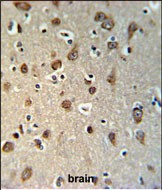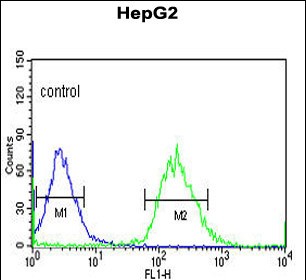YMEL1 Antibody (N-term)
Affinity Purified Rabbit Polyclonal Antibody (Pab)
- 产品详情
- 文献引用 : 4
- 实验流程
- 背景知识
Application
| WB, IHC-P, FC, E |
|---|---|
| Primary Accession | Q96TA2 |
| Other Accession | Q925S8, O88967 |
| Reactivity | Human, Hamster |
| Predicted | Mouse, Rat |
| Host | Rabbit |
| Clonality | Polyclonal |
| Isotype | Rabbit IgG |
| Calculated MW | 86455 Da |
| Antigen Region | 191-219 aa |
| Gene ID | 10730 |
|---|---|
| Other Names | ATP-dependent zinc metalloprotease YME1L1, 3424-, ATP-dependent metalloprotease FtsH1, Meg-4, Presenilin-associated metalloprotease, PAMP, YME1-like protein 1, YME1L1, FTSH1, YME1L |
| Target/Specificity | This YMEL1 antibody is generated from rabbits immunized with a KLH conjugated synthetic peptide between 191-219 amino acids from the N-terminal region of human YMEL1. |
| Dilution | WB~~1:1000 IHC-P~~1:100~500 FC~~1:10~50 E~~Use at an assay dependent concentration. |
| Format | Purified polyclonal antibody supplied in PBS with 0.09% (W/V) sodium azide. This antibody is purified through a protein A column, followed by peptide affinity purification. |
| Storage | Maintain refrigerated at 2-8°C for up to 2 weeks. For long term storage store at -20°C in small aliquots to prevent freeze-thaw cycles. |
| Precautions | YMEL1 Antibody (N-term) is for research use only and not for use in diagnostic or therapeutic procedures. |
| Name | YME1L1 |
|---|---|
| Synonyms | FTSH1, YME1L |
| Function | ATP-dependent metalloprotease that catalyzes the degradation of folded and unfolded proteins with a suitable degron sequence in the mitochondrial intermembrane region (PubMed:24315374, PubMed:26923599, PubMed:27786171, PubMed:31695197, PubMed:33237841, PubMed:36206740). Plays an important role in regulating mitochondrial morphology and function by cleaving OPA1 at position S2, giving rise to a form of OPA1 that promotes maintenance of normal mitochondrial structure and mitochondrial protein metabolism (PubMed:18076378, PubMed:26923599, PubMed:27495975, PubMed:33237841). Ensures cell proliferation, maintains normal cristae morphology and complex I respiration activity, promotes antiapoptotic activity and protects mitochondria from the accumulation of oxidatively damaged membrane proteins (PubMed:22262461). Required to control the accumulation of nonassembled respiratory chain subunits (NDUFB6, OX4 and ND1) (PubMed:22262461). Involved in the mitochondrial adaptation in response to various signals, such as stress or developmental cues, by mediating degradation of mitochondrial proteins to rewire the mitochondrial proteome (PubMed:31695197). Catalyzes degradation of mitochondrial proteins, such as translocases, lipid transfer proteins and metabolic enzymes in response to nutrient starvation in order to limit mitochondrial biogenesis: mechanistically, YME1L is activated by decreased phosphatidylethanolamine levels caused by LPIN1 activity in response to mTORC1 inhibition (PubMed:31695197). Acts as a regulator of adult neural stem cell self-renewal by promoting mitochondrial proteome rewiring, preserving neural stem and progenitor cells self-renewal (By similarity). Required for normal, constitutive degradation of PRELID1 (PubMed:27495975). Catalyzes the degradation of OMA1 in response to membrane depolarization (PubMed:26923599). Mediates degradation of TIMM17A downstream of the integrated stress response (ISR) (PubMed:24315374). Catalyzes degradation of MICU1 when MICU1 is not assembled via an interchain disulfide (PubMed:36206740). |
| Cellular Location | Mitochondrion inner membrane Mitochondrion |
| Tissue Location | High expression in cardiac and skeletal muscle mitochondria. |
For Research Use Only. Not For Use In Diagnostic Procedures.

Provided below are standard protocols that you may find useful for product applications.
BACKGROUND
YMEL1 is the human ortholog of yeast mitochondrial AAA metalloprotease, Yme1p. It is localized in the mitochondria and can functionally complement a yme1 disruptant yeast strain. It is proposed that this gene plays a role in mitochondrial protein metabolism and could be involved in mitochondrial pathologies.
REFERENCES
Grupe, A., et al. Am. J. Hum. Genet. 78(1):78-88(2006)
Deloukas, P., et al. Nature 429(6990):375-381(2004)
Clark, H.F., et al. Genome Res. 13(10):2265-2270(2003)
终于等到您。ABCEPTA(百远生物)抗体产品。
点击下方“我要评价 ”按钮提交您的反馈信息,您的反馈和评价是我们最宝贵的财富之一,
我们将在1-3个工作日内处理您的反馈信息。
如有疑问,联系:0512-88856768 tech-china@abcepta.com.






















 癌症的基本特征包括细胞增殖、血管生成、迁移、凋亡逃避机制和细胞永生等。找到癌症发生过程中这些通路的关键标记物和对应的抗体用于检测至关重要。
癌症的基本特征包括细胞增殖、血管生成、迁移、凋亡逃避机制和细胞永生等。找到癌症发生过程中这些通路的关键标记物和对应的抗体用于检测至关重要。 为您推荐一个泛素化位点预测神器——泛素化分析工具,可以为您的蛋白的泛素化位点作出预测和评分。
为您推荐一个泛素化位点预测神器——泛素化分析工具,可以为您的蛋白的泛素化位点作出预测和评分。 细胞自噬受体图形绘图工具为你的蛋白的细胞受体结合位点作出预测和评分,识别结合到自噬通路中的蛋白是非常重要的,便于让我们理解自噬在正常生理、病理过程中的作用,如发育、细胞分化、神经退化性疾病、压力条件下、感染和癌症。
细胞自噬受体图形绘图工具为你的蛋白的细胞受体结合位点作出预测和评分,识别结合到自噬通路中的蛋白是非常重要的,便于让我们理解自噬在正常生理、病理过程中的作用,如发育、细胞分化、神经退化性疾病、压力条件下、感染和癌症。









